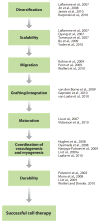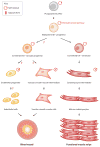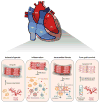Bioengineering heart muscle: a paradigm for regenerative medicine
- PMID: 21568715
- PMCID: PMC3405288
- DOI: 10.1146/annurev-bioeng-071910-124701
Bioengineering heart muscle: a paradigm for regenerative medicine
Abstract
The idea of extending the lifetime of our organs is as old as humankind, fueled by major advances in organ transplantation, novel drugs, and medical devices. However, true regeneration of human tissue has become increasingly plausible only in recent years. The human heart has always been a focus of such efforts, given its notorious inability to repair itself following injury or disease. We discuss here the emerging bioengineering approaches to regeneration of heart muscle as a paradigm for regenerative medicine. Our focus is on biologically inspired strategies for heart regeneration, knowledge gained thus far about how to make a "perfect" heart graft, and the challenges that remain to be addressed for tissue-engineered heart regeneration to become a clinical reality. We emphasize the need for interdisciplinary research and training, as recent progress in the field is largely being made at the interfaces between cardiology, stem cell science, and bioengineering.
Figures






References
-
- Severs NJ. The cardiac muscle cell. BioEssays. 2000;22:188–99. - PubMed
-
- Am. Heart Assoc. American Heart Association Cardiovascular Disease Statistics. Washington, DC: Am. Heart Assoc; 2008.
-
- Saltzman WM. Tissue Engineering: Engineering Principles for the Design of Replacement Organs and Tissues. New York: Oxford Univ. Press; 2004.
MeSH terms
Grants and funding
LinkOut - more resources
Full Text Sources
Other Literature Sources

